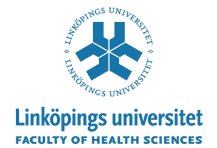 |
Visa svensk kursplan |
|
COURSE CATEGORY Single subject course MAIN FIELD OF STUDY SUBJECT AREA |
COURSE CODE | 8FA031 |
Learning Outcomes
By the end of the course the students will be able to:
-Identify, understand and explain medical, neurobiological phenomenon
-Relate the new knowledge to cellular and molecular mechanisms
-Integrate knowledge from different biological and medical area in order to explain a neurobiological phenomenon
-Evaluate their new knowledge in relation to current research in medical neurobiology
-Discuss and evaluate the results of scientific publications
Students who have failed the course or part of the course twice are entitled to request another examiner at the new examination occasion.
Extent of re-examination
The extent of a re-examination shall be similar to the regular examination.
Entries for examinations
Rules for entries for examination are given in the course plans. In addition the "Regulations regarding examinations and examiners" laid down by decision of Linköpings University (Dnr LiU 1109/00-40) apply.
Applicants with a degree from a non-Swedish university must enclose an official examination certificate of at least three years of fulltime studies in subjects with relevance for Life Science, such as biology, chemistry, medicine or the like.
Documented knowledge of English equivalent to ”Engelska B”; i.e. English as native language or an internationally recognized test, e.g. TOEFL (miminum scores: Paperbased 550 + TWE-score 4.0, computerbased 213 and internetbased 79), IELTS, academic (minimum score: Overall band 6.0 and no band under 5.0), or equivalent.
Planning and implementation of the course shall be carried out from the wording in this course plan. The evaluation of the course should therefore consider the question how well the course agrees with the course plan. Written evaluation will take place at a scheduled time at the end of the course.
Electronic evaluation of the course will also take place in accordande with Linköping University´s regulations (Dnr LiU 780/06-04).
Certificate
At the student´s request, a course certificate may be issued by the director of studies for courses or, according to delegation, by the head of the department/director of programme studies.
Additional Information
Students should have knowledge in cell biology, cell signalling and communication, histology and pathology of the cells/tissue in the nervous system at basic level.
The course is given in such a way that both men´s and women´s experiences and knowledge are foregrounded and developed.
If the course is withdrawn, or is subject to major changes, examinations according to this course plan are normally offered on a total of three occasions within a year, one of them in close connection with the first examination.
|
||||||||||||||||||||||||||||||||||||||||||||||||||||||||||||||||||||||||||||||